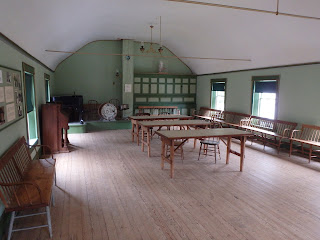Saturday evening of our Rockville weekend, Joe grilled Leg of Lamb, and they had some couples in for a meal with us. After church on the Sunday, Joe and Sandy took us on a quick driving tour around the area. We drove through the cemetery, Oakridge Dairy, Country Pure's juice plant, and Kloter Farms. After we changed clothes and said farewell, we started our journey to the Maine coast. Our first stop was to be at the
Kittery Trading Post, but it was closed by the time we arrived. We kept driving until we reached Freeport, Maine, where we decided to spend the night. Freeport is home to L.L.Bean and their flagship store, which happens to be open 24/7.
In the morning we continued our drive up the coast, stopping to visit a lighthouse, eat at Shaw's Fish and Lobster Wharf, and enjoy the rocky coast scenery. We got to the Bar Harbor area late afternoon and checked into our cabin at Hinkley's Dreamwood Cottages. The resort is quaint, old style Maine and a little rustic, but the cabin was clean, comfortable, and suited our needs. We were often surprised by acorns falling on the roof, deck or our van during our stay.

We spent the rest of the week in and around Acadia National Park. Acadia was the first National Park East of the Mississippi River; formerly Sieur de Monts National Monument, proclaimed by President Woodrow Wilson in 1916. The park was renamed Acadia National Park in 1929. Most of the park is on Mount Desert Island, and includes about half of the Island. It receives about 3.5 million visitors a year, and being one of the smaller parks by size, it can be very crowded during peak season. Fortunately we visited in a lull period. We visited the park's attractions, hiked, picnicked, climbed mountains, explored the small coast villages, relaxed, and ate good food.
Lemonade and popovers at Jordan Pond House.
We drove to the top of Cadillac Mountain and hiked around the top. Cadillac Mountain is the highest point on the North Atlantic seaboard, and is the first place in the U.S. that you can see the sunrise, fall through spring. We didn't bother to get up early enough for the sunrise! While hiking around on top of Cadillac, I met a Park Ranger/Forest Service intern who happened to be from Tremont. She had just graduated from Monmouth College and had had Fred W. as a history professor.
The mountains in Acadia are not the Rocky Mountains, but they were fun to climb and gave beautiful views of the park, ocean, and harbors. I climbed The Beehive, Acadia, Penobscot, Gorham, and South Bubble Mountains. The old farmer's wife, despite the pain from having an emergency wisdom tooth extraction prior to leaving home, climbed Gorham with me and accidentally climbed the South Bubble also.
Looking down on Sand Beach.
Bubble rock.
Bar Harbor in the distance.
On our rainy day, we drove to the eastern tip of Maine and across the border into Canada to Campobello Island and toured Franklin Roosevelt's summer cottage. Franklin spent his summers on Campobello from his childhood, eventually owning his own cottage. In 1939, after Franklin contracted Polio, he was unable to visit his "beloved Island" much, but Eleanor and children continued using it every summer until her death in 1962. The family then deeded it to the U.S. and Canadian governments. The cottage and area are now a part of Roosevelt Campobello International Park.


We ate our share of lobster while in Maine. I had grilled lobster, lobster roll, and lobster chowder. We learned that for the early settlers and Native Americans, lobster was so plentiful and easy to catch in the tide pools (by hand or net), that it was considered poor mans food! Lobster was probably served at the first Thanksgiving. Today, Maine is the largest lobster producing state in the nation. There are about 6427 licensed lobster-men (and women) with a annual harvest of about 276.5 million pounds of lobster.
We ate at this unique restaurant twice. It had indoor and outdoor seating, with a mostly outdoor kitchen. They kept a fire under the lobster pots all day so they were ready to boil lobster at all times.
A lobsterman's wharf in a fishing harbor full of lobstering boats.
The iconic Bass Harbor Head Lighthouse.
At the end of the week we bid farewell to the coast and started our western travels across Maine, New Hampshire, and into Vermont.
And the border shall go down to Jordan, and the goings out of it shall be at the salt sea: this shall be your land with the coasts thereof round about.
Numbers 34:12






















































